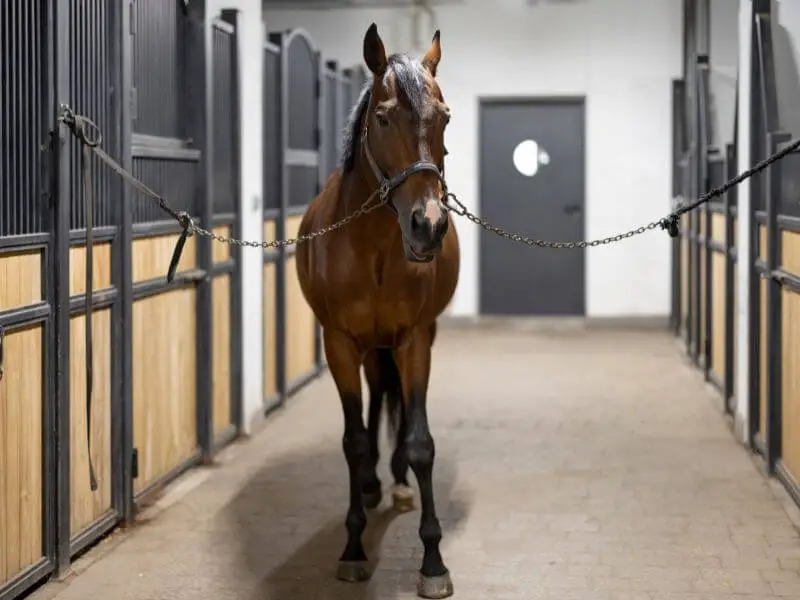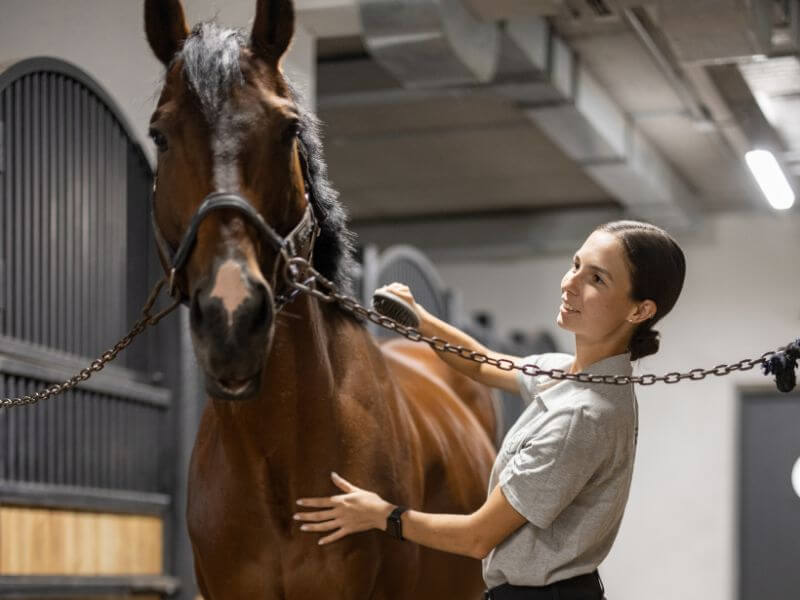Are you unsure how to properly put on a horse’s fly sheet or take it off?
Don’t worry, I’ve got you covered. As a former working student who worked at a barn with over 70 horses that wore fly sheets, I’m here to guide you through the entire process.
We’ll cover the basics of applying and removing a horse fly sheet, so you can protect your horse from pesky flies while ensuring their comfort and well-being.
Fly sheets are a horse owner’s best friend when it comes to keeping our four-legged pals safe from irritating flies and other pests. To ensure that your horse is well-protected, it’s crucial to know the ins and outs of proper fitting, application, and removal.
So, let’s get started!
Be sure to check out this helpful article for some recommendations on some of the best fly sheets for your horse.
Table of Contents
Putting on the Fly Sheet
Here’s a detailed breakdown of the steps to put on a fly sheet for your horse:
Step 1- Prepare your horse: Make sure your horse is calm and under control. You can either tie them up, blanket them in their stall, or have a helper hold them steady.
Step 1- Approach your horse with the fly sheet: Gently approach your horse to avoid startling them. Talk to them softly and let them know you’re there.
Step 2 Fold the fly sheet: Fold the fly sheet in half lengthwise, making it easier to handle and position.
Step 3- Place the fly sheet over the withers: Carefully drape the folded fly sheet over the horse’s withers, unfolding it to cover their entire body.
Step 4- Fasten the front buckles: Secure the front buckles of the sheet around the horse’s chest, making sure they’re snug but not too tight.
Step 5- Secure the belly straps: Wrap the belly straps around the horse’s belly and fasten them securely. Ensure they’re tight enough to stay in place but not so tight that they cause discomfort.
Step 6- Adjust the leg straps: Fasten the leg straps, ensuring a snug fit without restricting the horse’s movement.
Step 7- Put the tail through the strap on the tail flap (if applicable): Slide the horse’s tail through the strap on the tail flap. Not all fly sheets even have a tail flap, although I would recommend one. Even less fly sheets have a strap on the tail flap. This just adds a level of security, keeping the fly sheet more stable when the horse rolls. Some of the rambo blankets have these.
Step 8- Pull the neck cover up and fasten it: If the fly sheet has a neck cover, pull it up over the horse’s neck and fasten it securely.
Step 9- Check for gaps: Inspect the fly sheet to make sure there are no gaps between the sheet and the horse’s body where flies can enter. If there is a belly guard make sure it is tight enough to keep flies out but not constricting the horse.
If there are gaps in the shoulders then the fly sheet is probably too big.

Taking Off the Fly Sheet
When it’s time to remove the fly sheet, follow these steps:
Step 1- Stay calm and speak softly: Approach your horse calmly, speaking softly to let them know you’re there. Horses get startled easily and especially if they are focused on eating for not paying attention to their surroundings. You want to warn them of your presence before starting to take off there sheet, so there’s no surprises.
Step 2- Unsnap the leg straps: Gently unbuckle or unsnap the leg straps, be careful to not let them fall and hit the horses legs.
Step 3- Take the tail out of the tail strap: Carefully slide the tail out of the tail strap on the tail flap.
Step 4- Unfasten the surcingle or belly straps: Undo the belly straps. If there is a belly flap prevent it from suddenly dropping and spooking the horse.
Step 5- Undo the velcro on the neck cover: If the fly sheet has a neck cover, undo the velcro fastenings and fold back the neck cover on the horses back.
Step 6- Undo the front buckles: Unfasten the front buckles and velcros if there is any.
Step 7- Remove the fly sheet: To remove the fly sheet, grab the top by the withers. If there’s a neck cover, make sure it is folded back first. Then, grab the back of the sheet by the tail, bring the tail end toward the withers, check the tail is not in the strap on the tail flap because it will get caught. Then gently pull the fly sheet off the horse’s side towards you.
Additional Tips for Taking Off the Fly Sheet
- Be gentle and patient: Your horse may be tired or sensitive after wearing the fly sheet, so take your time and be gentle when removing it.
- Inspect the horse’s skin: Check for any signs of rubbing, irritation, or injuries that may have occurred while wearing the fly sheet.
- Clean and store the fly sheet: Make sure to clean the fly sheet and store it properly after use. This will help prolong its lifespan and keep it in good condition for future use.
Staying Safe When Blanketing Your Horse
I can’t emphasize enough the importance of safety when it comes to blanketing your horse and dealing with horses in general.
Let’s go over some things about keeping your four-legged friend happy and healthy and you safe as well! Some of this is summarizing and a repeat of what was said before, but this will help it stick in your mind.
So, here are some essential safety tips to keep in mind:
Be Cautious And Alert When Blanket
Keep yourself safe! When approaching your horse with the fly sheet, make sure to move calmly and gently to avoid startling them. A spooked horse can be unpredictable, and we want to ensure your safety as well as your horse’s.
Stay alert and focused throughout the process.
While putting on or taking off the fly sheet, pay attention to your horse’s reactions, and be ready to adjust your actions if needed. A well-timed response can prevent accidents and keep both you and your horse safe.
Get Help If Needed
If you’re new to blanketing or dealing with an anxious horse, having a helper hold your horse steady. This can make the process smoother and safer for everyone.
Two pairs of hands are better than one, especially when it comes to keeping you and your equine friend secure!
Properly secure all straps and buckles
Straps and buckles – your best friends!
Make sure you secure them properly to avoid any “oops” moments. We don’t want that fly sheet slipping, getting twisted and causing discomfort to your precious equine partner! I have seen on windy days the back of the sheets and blankets without leg or tail straps get blown over the horses head.
You very well may end up with a panicking horse on your hands.
Regularly check for signs of rubbing or irritation
Keep an eagle eye on your horse’s skin. Look out for redness, hair loss, or any signs that say, “Hey, this fly sheet isn’t fitting quite right.” Regular checks will help you address any issues pronto!
Rubbing on the shoulders are the most common problem with ill fitting sheets.
Monitor your horse’s comfort level
Horse whisperer time! Tune in to your horse’s behavior while they’re wearing the fly sheet.
If they’re acting all agitated or just plain uncomfortable, it’s time to reevaluate that fit, my friend.
Never leave a fly sheet on all the time
Give your horse a break – they need it!
Fly sheets are fantastic, but your horse needs some naked time too. During these breaks, are good times to check for any signs of rubbing, irritation, or pesky cuts.
If your horse has a stall you may take off the sheet at night time and put a fan on to blow off the flies.

You’re Ready to Put on a Fly Sheet
Congratulations! Now you know how to properly put on and take off a horse fly sheet.
By following these steps and keeping safety in mind, you’ll be able to protect your horse from annoying flies and other pests while ensuring their comfort and well-being.
Remember, a well-fitted fly sheet is essential for your horse’s health and happiness.on the best fly sheets for horses.
| Key Takeaways |
|---|
| 1. Preparing your horse: Ensure they are calm and under control before starting the process. |
| 2. Approach your horse gently with the fly sheet to avoid startling them. |
| 3. Follow the step-by-step guide for putting on the fly sheet, including adjusting straps and fastening buckles. |
| 4. Regularly check for signs of rubbing while your horse wears the fly sheet. |
| 5. Follow the expanded guide for removing the fly sheet, being gentle and patient throughout the process. |
| 6. Inspect the horse’s skin after removing the fly sheet for any signs of irritation or injury. |
| 7. Clean and store the fly sheet properly after use to prolong its lifespan. |
| 8. Prioritize safety when blanketing your horse by securing all straps and monitoring their comfort level. |
| 9. Give your horse breaks from wearing the fly sheet and never leave it on all the time. |
What is one new tip or piece of information you learned from this article that you will apply when using a fly sheet for your horse?
Cheers, Kacey
P.S. Did you like this article? Gallop over to:

